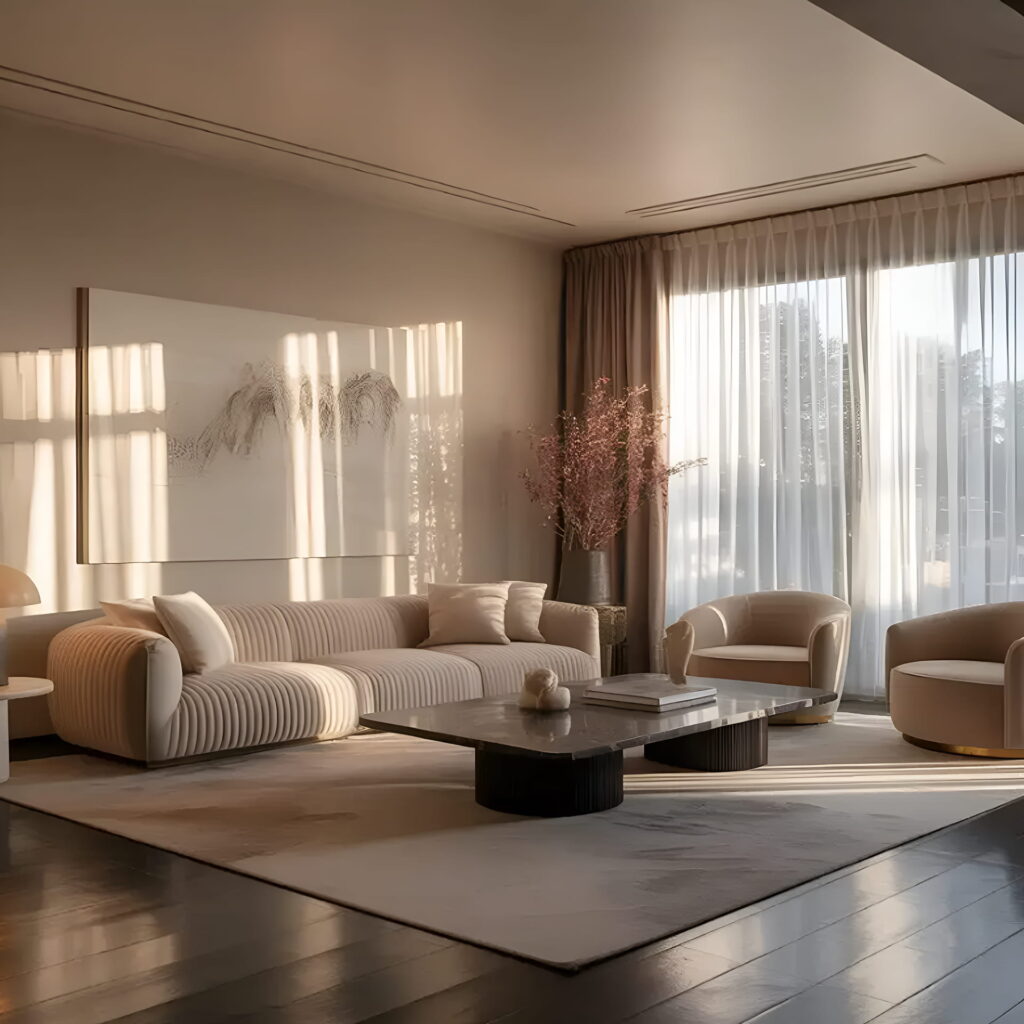Have you ever sat on a sofa in Dubai and instantly felt the heat cling to the fabric? That’s the challenge many homeowners face when choosing upholstery in a desert climate. The right choice can make your home cooler, more stylish, and comfortable year-round. If you’re working with an interior designer or planning your own decor updates, understanding fabric selection is key. From durability to breathability, every detail matters—especially in Dubai’s warm, humid environment where the weather constantly tests fabrics.
Understanding the Impact of Dubai’s Climate on Fabrics
Dubai’s year-round sunshine and high humidity mean that not all materials can withstand daily use without fading, cracking, or losing their charm. The climate’s intensity makes it vital to choose fabrics that are breathable, moisture-resistant, and colorfast. For example, fabrics like cotton, linen, and microfiber handle temperature changes well. Synthetic options like polyester can also perform better if treated to resist heat and UV rays. Homeowners who consider these factors early save money on frequent replacements and enjoy lasting comfort.
Why Fabric Choice Matters for Everyday Comfort
Upholstery is more than just what covers your furniture—it affects how your home feels. A well-chosen fabric can make a space cooler, cozier, or more elegant, depending on its texture and quality. In Dubai, it’s common for families to entertain guests or enjoy cozy evenings indoors, so the materials used in sofas, chairs, and cushions need to be soft yet practical. Breathable materials like cotton blends are excellent because they reduce sweating and don’t trap heat. This simple choice creates a noticeable difference in your daily comfort.
Choosing Fabrics that Suit Dubai’s Heat
When selecting upholstery, always consider heat reflection and breathability. Natural fabrics like cotton and linen are known for their cool touch and light texture, making them perfect for hot weather. They allow air to flow through, which helps keep the surface temperature lower. On the other hand, leather or velvet, while luxurious, may not be ideal unless your home has strong air conditioning. For modern apartments and villas in Dubai, microfiber is a smart option—it resists stains, handles moisture well, and keeps its shape even in humidity.
Durability and Maintenance in Humid Conditions
Humidity can weaken fabrics over time, especially if the materials trap moisture. Upholstery that isn’t properly ventilated may start showing signs of mildew or color fading. This is why homeowners should look for fabric with easy cleaning properties and high resistance to wear. Blended fabrics with protective coatings work particularly well in Dubai’s weather. Regular maintenance also plays a role—vacuuming your upholstery and keeping it away from direct sunlight extends its lifespan. Durability doesn’t have to compromise style if you choose wisely.
Balancing Aesthetic and Functionality
Every home in Dubai reflects a unique personality. Whether your interior style leans toward contemporary, minimalistic, or traditional Arabic design, your fabric choice should match that visual flow. Neutral tones like beige, sand, and gray are popular because they blend well with Dubai’s natural light. But beyond looks, think about texture and comfort. A good interior designer will always balance appearance with practical use, recommending materials that complement both your taste and the local climate.
Selecting the Right Upholstery for Different Spaces
Different rooms demand different fabric types. In living rooms, where guests often gather, durable materials like treated cotton or microfiber are ideal. Bedrooms, on the other hand, can benefit from soft and cozy fabrics like linen blends. For outdoor areas such as balconies or terraces, waterproof and UV-resistant fabrics are essential. Choosing wisely for each space ensures every area of your home feels welcoming while lasting longer under Dubai’s weather conditions.
Understanding Fabric Grades and Quality
Not all fabrics are created equal. Quality can vary even among similar-looking materials. High-grade fabrics tend to have tighter weaves and better resistance to fading. Before buying, always feel the texture and ask about its rub count—a measure of durability. It’s also smart to consider how the color and pattern will hold up under Dubai’s bright sunlight. Opting for light tones helps reflect heat and maintain a fresh, airy feel inside your home.
The Role of an Interior Designer in Fabric Selection
Working with an interior designer can make this process much easier. Designers have the experience to match fabrics with your space, color scheme, and daily lifestyle. They understand the balance between aesthetics, function, and long-term maintenance. From selecting bespoke wardrobes to curating fabric palettes that resist Dubai’s harsh climate, their expertise ensures every element in your home feels cohesive. Professional guidance not only saves time but also helps avoid costly mistakes that come with unsuitable material choices.
How to Test Fabrics Before Buying
Before finalizing any fabric, it’s wise to test how it feels and behaves under different conditions. You can request samples from showrooms or suppliers to check color and texture in your home lighting. A simple heat test—by leaving a sample near a sunny window—shows how well it handles Dubai’s heat. If the material fades or becomes sticky, it might not be suitable. This small step gives you peace of mind that your upholstery will stand the test of time.
Eco-Friendly and Sustainable Fabric Choices
Sustainability is becoming increasingly important in Dubai’s design scene. Many homeowners now prefer eco-friendly options like organic cotton, bamboo fabric, or recycled polyester. These materials are not only better for the environment but also tend to perform well in warm climates. Sustainable fabrics often come with natural cooling properties and are less likely to release toxins when exposed to heat, making them ideal for healthy, family-friendly homes.
Cost and Value Considerations
Price often plays a big role in fabric selection, but choosing the cheapest option can lead to frequent replacements. Investing in quality upholstery may cost more initially, but it saves money long-term. A durable, easy-to-clean fabric stays attractive for years, reducing reupholstery costs. Also, consider how the fabric complements your furniture’s structure and color palette—this ensures that every piece enhances the space harmoniously without the need for frequent updates.
Common Mistakes to Avoid
One of the most common mistakes homeowners make is selecting a fabric based only on its appearance. Glossy or dark materials may look beautiful, but can trap heat. Another error is ignoring how much sunlight enters the room. Direct UV exposure can quickly fade colors and weaken fibers. A little planning and consultation with a design professional can prevent these issues and keep your furniture looking elegant and cool for years.
Bringing Everything Together
The right upholstery can completely transform your home’s comfort and style. Understanding Dubai’s climate helps you make smarter fabric choices that combine looks, comfort, and durability. Whether you’re refreshing your living space or working with an interior designer to plan a major update, keep in mind that every detail—from texture to tone—matters in this environment. High-quality upholstery adds not only beauty but long-lasting value to your interiors.
Conclusion
If you’re looking for professional help with fabric selection, space planning, or full interior design, Rawaa Interiors is here to help. With years of experience in Dubai, we bring your ideas to life through expert design, quality craftsmanship, and reliable project execution. From soft furnishings to bespoke wardrobes, we handle every detail with care and creativity. You can contact us at +971 50 222 8146 or +971 52 934 3293, or reach us by email at interiorsbyalrawaa@outlook.com.
FAQs
1. What is the best type of fabric for Dubai’s humid weather?
Cotton and linen are ideal because they breathe easily and stay cool. These natural fibers resist moisture better than synthetic ones, making them perfect for Dubai’s humid and hot conditions.
2. How often should I clean or maintain my upholstered furniture?
Upholstery in Dubai should be vacuumed weekly and professionally cleaned at least twice a year. Regular maintenance prevents dust buildup, keeps colors fresh, and extends the fabric’s life.
3. Are leather sofas a good choice for Dubai homes?
Leather can be used if your home has strong air conditioning, but it tends to trap heat and become sticky. Breathable alternatives like microfiber or treated cotton are more comfortable options for daily use.
4. Can I mix different fabrics in one room?
Yes, mixing fabrics adds texture and depth to your design. The key is to maintain a consistent color palette and use materials that complement each other both visually and functionally.
5. How can Rawaa Interiors help with my upholstery needs?
Rawaa Interiors can guide you through every step, from fabric selection to final installation. Our team ensures each material suits Dubai’s climate while enhancing your home’s comfort and style.

